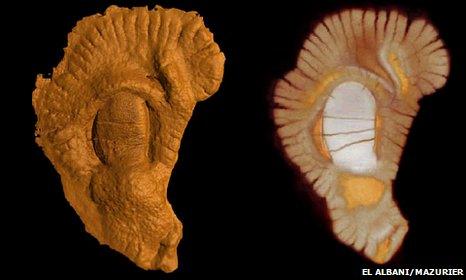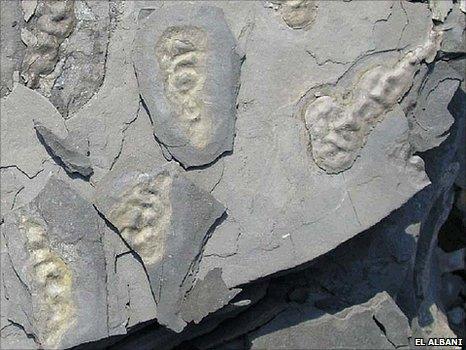'Cookie-shaped' fossils point to multicellular life
- Published

A virtual reconstruction of the inner and outer form of one of the fossils
Relics of some of the first stirrings of modern life may have been uncovered.
Scientists report in the journal Nature the discovery of centimetre-sized fossils they suggest are the earliest known examples of multicellular life.
The specimens, from Gabon, are 2.1 billion years old - 200 million years older than for any previous claim.
Abderrazak El Albani and colleagues describe the fossils' distinctive appearance as resembling irregularly shaped "wrinkly cookies".
The step from single-celled to multicellular organisation was a key step in the evolution of life on Earth and set the scene for the eventual emergence of all complex organisms, including animals and plants.
The big question is whether the new West African specimens truly represent large organisms growing in a co-ordinated manner, or are merely a record of the remains of aggregations of unicellular bacteria.
The team tells Nature that its analysis of the fossils' three-dimensional structure using X-ray microtomography leans it towards the former explanation.
The fossils would have existed during a period in Earth history that came shortly after the so-called Great Oxidation Event, when free oxygen concentrations in the atmosphere rose rapidly.
Another oxygen surge that occurred about half a billion years ago co-incided with the Cambrian Explosion - the huge spurt in evolution that established all the major animal groupings.
"The evolution of the Gabon macrofossils, representing an early step toward large-sized multicellularity, may have become possible by the first boost in oxygen," Dr El Albani and colleagues said in a statement, "whereas the Cambrian Explosion could have been fuelled by the second.
"Why it took 1.5 billion years for the multicellular organisms to take over is currently one of the great unsolved mysteries in the history of the biosphere."

The Gabonese fossils were laid down in shales